Matador Network's Blog, page 85
December 18, 2024
I Tried the Viral TikTok Airplane Hair Curling Trick. Here’s How It Went.

If you’ve been anywhere near Instagram or TikTok recently and have long hair, you’ve probably seen some version of the viral hair hack going around. All you need is long-ish hair, a pair of socks, and a lot of time, and you can curl your hair without any heat or effort. There are various versions on the internet, but the first one I saw was focused on how to do it during a long red-eye flight, ensuring that you can sleep on the plane and wake up at your destination with perfect, bouncy curls, looking like you styled your hair on the plane.
View this post on Instagram
A post shared by ERIN RIDER (@erinrider)
As someone with long hair, very little hair styling skills, and a 30-hour flight coming up, I decide to try it.
How curling hair with socks works
Here’s my hair after a full day outside in Nairobi (and my face after a nine-hour red-eye flight), before trying the hair curling with socks trick. Photo: Suzie Dundas
According to Instagram and Tiktok, this hack is pretty easy. You start by dividing your hair into two even sections (or three, if you have tons of hair). Then, wrap your hair around a tube sock (holding one end in your mouth while you wrap helps). When you reach the end of your hair, fold the open end of the tube sock over the wrapped hair to keep it in place. You should end up with something that looks like puppy ears on each side of your head. You’ll do this with perfect dry, unstyled hair.
Then, just wait. I tried this on the longest segment of my travel pattern, from Frankfurt, Germany, to San Francisco, California. I landed in Frankfurt after a nine-hour flight from Nairobi, Kenya, and spent the day before that walking around Kenya. So my hair was clean, but a little windblown and wavy, thanks to some light hunidity. Otherwise, my hair is normally pretty straight, which is one reason I was keen to give this hair travel hack a try.
The process
I wrapped my hair on each side around cotton tube socks. Photo: Suzie Dundas
After take off, I pulled out my tube socks to give it a try. Though most videos don’t mention this, I’m guessing the socks are supposed to be clean, which mine weren’t — I was flying home after a 12-day safari, and there are strict weight limits on bags on small bush planes. So I had to work with what I had, which was dirty socks. It’s possible that was part of the reason (spoiler) it didn’t work very well, as the socks may have had some oil or dirt on them that weighed down my hair.
My hair is normally pretty straight and very fine and soft, almost like silky baby hair. That may sound nice, but in reality, it just means my hair breaks easily, gets frizzly, and doesn’t hold curls well. So I knew it would be an uphill battle, but considering how long my flight was, it seemed worth trying just to have something to do.
However, it didn’t take long to realize that my tube socks were not long enough. I either had to stretch the sock a ton, which made it not stay put, or wrap all my hair along a relatively short section of sock, which meant I kind of had to fold my hair upward toward the tips. I ended up trying to stretch the sock as much as possible, and using a hair tie to keep it in place near the top. I also ran out of sock and didn’t have enough fabric left to fold it fully over the wrapped part, so I kind of had to squish my hair a little to make it all fit.
Next step: nothing
After wrapping, I waited about 10 hours to see if curling my hair with socks would actually work. Photo: Suzie Dundas
After wrapping my hair as well as I could with my too-short socks, I waited. In most of the Instagram videos I’d seen, the women trying it had perfect makeup and looked exactly how you expect a social media influencer would. With no makeup, a lack of sleep, and having just spent nine hours on a flight, I certainly didn’t feel like my look was very chic. So I pulled up my hood to hide the dog ears and tried to find a way to settle into my economy seat headrest without making the socks fall out.
I left it in for about nine hours
Photo: Suzie Dundas
My flight from Frankfurt to San Francisco was just under 12 hours, so I probably left the sock curls in for about nine to 10 hours. The various videos I saw online didn’t say how long curling hair with socks takes, exactly, so I figured the longer, the better. Since my hair was pretty clean at the time (and clean hair doesn’t usually hold style quite as well), I wanted to maximize the odds that it would work. Plus, I had a hood to cover how ridiculous my dog ears looked.
Despite sleeping on the plane in a squished-down position, smashing my head against a cheap Lufthansa airplane pillow, and shifting and turning over and over for most of the flight, the socks stayed in pretty well. However, that’s probably because I used hir ties to hold the socks in place, which I wouldn’t have had to do if the socks I’d used had been longer. I had some flyaways and frizz around my head, but the socks kept most of the hair in otherwise.
The finished product
It worked, sort of. Photo: Suzie Dundas
It worked, kind of. As you can see from the photo above, it worked — for a bit. You can see the curls, and unfortunately, you can also see the weird angles around the bottom of my hair where I had to fold my hair and squish it around the bottom of the sock. I think that area would look a lot smoother and better curled if I had used a longer sock. One issue I also noticed is that you should curl your hair away from your face on either side. I curled them the same way, and as a result, both side of my hair are kind of curling to the left, which I think looks a little weird.
Unfortunately, by the time I picked up my luggage, got through customs, and rechecked my bag, the curls had mostly fallen out.

The curls had mostly fallen out about an hour after I removed the socks. Photo: Suzie
That’s probably because I used the wrong kind of product (I used a flyaway smoother before I put the socks in, but should have used a hairspray-type product) and because I really had to smush my hair into the socks to make them fit. Longer socks would have worked a lot better. The other issue is that I should have held the sock straight and wrapped my hair around it, like wrapping my hair around a pole, rather than twisting the sock and my hair together. When I air dry my hair, and just twist the ends as they’re drying, I get much better curls that seem to stay for a lot longer, even without using a product.

I’m not sure that curling my hair with socks worked any better than just twisting the ends while they’re wet, as seen here. Photo: Suzie Dundas
The verdict: does curling hair with socks on a long flight actually work?

The trick does curl your hair — but getting them to look nice (and getting the curls to stay in place) may take some practice. Photo: Suzie Dundas
My verdict is that yes, curling your hair with socks does work, usually. But it didn’t work well for me, probably because of the way I twisted it and using the wrong socks. Because my hair is fine, if I tried it again, I’d also use some kind of thickening or styling spray beforehand. However, people with hair that dries quickly might find that another method works better: about an hour or two before landing, get the ends of your hair damp in the airplane sink, comb them, and then just slowly twist the ends as they dry. For me, that’s a more efficient method — though I do want to try curling my hair with socks one more time with the right socks to see if that may make a difference. 
9 Cheap Houses in France That Even You Can Afford

Don’t let anyone convince you that your dream of moving to France to live a simple life filled with freshly baked bread, cheese, and buttery pastries is nothing but a pie in the sky. Moving abroad is possible, especially now that many of us can work remotely. And it doesn’t have to cost a fortune. While finding an affordable apartment with views of the Eiffel Tower isn’t going to happen, there are plenty of reasonably priced and charming properties throughout France’s countryside that will cost you less than $165,000. Whether you want a permanent residence or a vacation home, there are affordable houses for sale in France that can make your dreams of baguettes, camembert, and pains au chocolat become a reality.
1. Two-bedroom chalet in Mauroux, Lot: €125,350 ($131,524) Photo: Leggett Immobilier
Photo: Leggett Immobilier Photo: Leggett Immobilier
Photo: Leggett Immobilier Photo: Leggett Immobilier
Photo: Leggett ImmobilierThis small chalet consists of a sitting room/living room, a small but fully equipped kitchen, two good-sized bedrooms, and a shaded porch for enjoying meals. Being a chalet, everything inside and out is made of wood, creating a rustic and cozy atmosphere.
The chalet is located on a three-star resort aptly named “Village du Soleil” (Sunny Village). The resort houses 72 chalets and offers amenities such as a restaurant, swimming pool, tennis court, and children’s playground. The annual resort fees of €2,000 ($2,099), or €167 ($175) per month, cover the maintenance of the premises and equipment.
Mauroux is a small village with fewer than 600 inhabitants in the Lot Valley. Sunny Village is close to the region’s famous vineyards, historical sites, and the Lot River, where visitors can enjoy kayaking, fishing, and other activities.
See more photos and learn more2. Characterful stone house in Cruzy, Hérault: €109,000 ($114,366) Photo: Leggett Immobilier
Photo: Leggett Immobilier Photo: Leggett Immobilier
Photo: Leggett Immobilier Photo: Leggett Immobilier
Photo: Leggett ImmobilierThis small stone house, located on a quiet village street, has a unique three-level layout. A staircase from the street leads to the living space, which includes an eat-in kitchen and a sitting room that opens onto a small patio. The two bedrooms, shower room, and restroom are located on the top floor. The ground floor, at street level, serves as a storage and laundry room.
While updated to modern standards, the house maintains its traditional character with colorful vintage-patterned tiles, slanted ceilings, wooden beams, a fireplace, a wood stove, and retro built-ins that contribute to its comfortable atmosphere.
The village of Cruzy is situated 16 miles from the city of Béziers (with daily bus service), 22 miles from the beach, and just 75 minutes by car from the Spanish border. Despite its small size, Cruzy offers a bakery, deli, pharmacy, small grocery store, and café. The nearby town of Quarante, less than two miles away, provides additional amenities.
See more photos and learn more3. Small house with a huge yard and a pond in Chavin, Indre: €133,750 ($140,353) Photo: Leggett Immobilier
Photo: Leggett Immobilier Photo: Leggett Immobilier
Photo: Leggett Immobilier Photo: Leggett Immobilier
Photo: Leggett ImmobilierWhile this very small house could use some cosmetic updates, it has all the essentials: one bedroom, one bathroom, one kitchen, and one living room/sitting room, all in good condition. What makes this property exceptional isn’t so much the house but the land it sits on. At 3.7 acres, including a wooded area and a nearly two-acre pond teeming with various fish species, the property resembles a nature reserve more than a private yard. It’s the ideal spot for a single person or couple who wants to be immersed in nature — especially if they enjoy fishing.
This one-bedroom house features a fireplace and is off-grid, powered by a gas generator. It’s possible to install solar panels for a more sustainable power supply.
The village of Chavin is extremely small, with fewer than 300 inhabitants, guaranteeing peaceful surroundings. Despite its remote feel, the house is only a three-hour drive from Paris.
See more photos and learn more4. Three-bedroom, blue-shuttered house in Asnières-la-Giraud, Charente-Maritime: €149,875 ($157,254) Photo: Leggett Immobilier
Photo: Leggett Immobilier Photo: Leggett Immobilier
Photo: Leggett Immobilier Photo: Leggett Immobilier
Photo: Leggett ImmobilierIf the blue shutters on this lovely house located on a quiet street don’t capture your heart, the large sitting room with its painted wood beams and original fireplace surely will. With three bedrooms, two large living spaces, two bathrooms, and a generously sized kitchen, this charming house offers ample room for a family.
The property features two wood stoves and electric radiators throughout to keep you warm during winter. In summer, you can take advantage of the kitchen’s French doors that open to the yard, perfect for outdoor dining and sunbathing. While the yard needs some attention, it has significant potential.
Asnières-la-Giraud is a small village with fewer than 1,000 inhabitants, but the beautiful town of Saint-Jean-d’Angely is just 10 minutes away by car. Saint-Jean-d’Angely boasts the magnificent Royal Abbaye and is vibrant with numerous businesses, markets, fairs, and restaurants.
See more photos and learn more5. One-bedroom stone house in a remote village in Riols, Hérault: €70,000 ($73,446) Photo: Leggett Immobilier
Photo: Leggett Immobilier Photo: Leggett Immobilier
Photo: Leggett Immobilier Photo: Leggett Immobilier
Photo: Leggett ImmobilierThis incredibly affordable one-bedroom stone house, located in a remote hamlet, is undeniably small but incredibly charming. The traditional stone walls, wood beams, and wood stove in the living room give the home a cozy and rustic character.
The property’s location in the heart of the Haut Languedoc Regional Nature Park is its true selling point. The breathtaking views of mountains and forests more than compensate for any indoor space limitations.
While the property is situated in the small historic village of Riols and feels remote, the town of Saint-Pons-de-Thomières, with its variety of cafés, bars, and restaurants, is just a 15-minute drive away.
See more photos and learn more6. Fully renovated three-bedroom stone house in Saint-Junien-la-Bregère, Creuse: €149,950 ($157,354) Photo: Leggett Immobilier
Photo: Leggett Immobilier Photo: Leggett Immobilier
Photo: Leggett Immobilier Photo: Leggett Immobilier
Photo: Leggett ImmobilierThis fully renovated three-bedroom house comes with a small pool, two large fields, two barns, and six horse stables — offering plenty of space for a family with ambitious projects. Every room inside the house is spacious, and the patio provides spectacular rural views. Multiple outdoor spaces are perfect for setting up patio furniture and enjoying al fresco meals.
While the interior has been beautifully modernized, the stunning traditional stone exterior remains intact. The property is located in a quiet, rural setting but is conveniently close to several small towns (ranging from five to 20 minutes away by car) that offer all necessary amenities.
See more photos and learn more7. Former farmhouse with two bedrooms and a large yard in Guesnes, Vienne: €89,000 ($93,411) Photo: Leggett Immobilier
Photo: Leggett Immobilier Photo: Leggett Immobilier
Photo: Leggett Immobilier Photo: Leggett Immobilier
Photo: Leggett ImmobilierThough small and squat from the outside, this former farmhouse is expertly laid out to welcome a family. Two bedrooms are located below the eaves on a mezzanine, while the ground floor features a kitchen, living room/sitting room, bathroom, and an additional room that could be converted into a third bedroom. Despite modernizations, the house retains its historical charm with clay tiles throughout the main floor, wood beams, a fireplace, a wood kitchen stove, and even a traditional bread oven in the yard.
The large, fenced yard is planted with diverse species, including fig trees, grapevines, pine trees, and rose bushes. An outbuilding provides storage, and a covered terrace is annexed to the house.
While Guesnes is a small village with fewer than 300 inhabitants, nearby towns offer all necessary conveniences.
See more photos and learn more8. Small, two-bedroom stone farmhouse in Chamberet, Corrèze: €129,990 ($136,432) Photo: Leggett Immobilier
Photo: Leggett Immobilier Photo: Leggett Immobilier
Photo: Leggett Immobilier Photo: Leggett Immobilier
Photo: Leggett ImmobilierWith its stone facade, green shutters, and slate roof, this picturesque farmhouse is immediately eye-catching, and its interior is equally charming. The renovation maintains the home’s quaint character, featuring wooden floors, stone walls, wood beams, and bedrooms nestled beneath the eaves.
The large yard includes a swimming pool, and the former bread oven has been cleverly transformed into a charming vacation rental.
Chamberet’s village center is less than 10 minutes away and provides everything you might need, including a bustling market, bakery, bars, restaurants, supermarket, and gas station. Bariousses Lake, just six miles away, offers swimming opportunities during the summer months.
See more photos and learn more9. 17th-century, eight-bedroom house in Saint-Pons-de-Thomières, Hérault: €165,000 ($173,178) Photo: Leggett Immobilier
Photo: Leggett Immobilier Photo: Leggett Immobilier
Photo: Leggett Immobilier Photo: Leggett Immobilier
Photo: Leggett ImmobilierThis 17th-century house boasts a total of 16 rooms, including eight bedrooms and four bathrooms, while preserving all its traditional features: high ceilings, a mix of beautiful vintage flooring, a majestic staircase, and a glass roof. The kitchen opens to a terrace perfect for outdoor dining, and the dining room features a grand fireplace — one of many in the house.
While some renovations are still needed, significant work has already been completed. For those not intimidated by ongoing improvements, this could be an ideal property. With its numerous bedrooms, the house also presents an opportunity to create a bed and breakfast and generate additional income.
Saint-Pons-de-Thomières is a small town of fewer than 2,000 inhabitants but offers all necessary daily businesses, including grocery stores, a café, bakery, and florist. 
A Luxe Ski Trip to France Is Cheaper Than Skiing in the US (Seriously)

If I told you that an all-inclusive ski vacation to The French Alps for a family of four can be cheaper than a trip to Aspen, you’d be correct to think, “prove it.” I certainly would.
Growing up, I was fortunate enough to learn to ski in France and Italy. Our family winter vacations were always to all-inclusive resorts where my parents would vanish early to black runs, leaving us kids in the capable hands of French or Italian ski instructors. We’d whizz down the slopes with our new friends from the kid’s club, singing “I’m a little teapot” as we cruised down the bunny runs. But it was more than just learning how to ski. It was a cultural education. I forgot how these experiences shaped me until last week, when after almost 25 years off the slopes, I returned to Tignes, in the French Alps, to experience it all over again with Club Med.
By no means is the idea of an all-inclusive ski vacation new to Europe — it’s been part of the ski vacation industry for some time. But Club Med seemed to be doing something special when it comes to two major selling points: it makes a ski vacation to Europe both affordable, and ridiculously straightforward.
 Photo: Club Med
Photo: Club Med Photo: Club Med
Photo: Club Med Photo: Club Med
Photo: Club MedPerched at an altitude of 6,890 feet (or 2,100 meters) above sea level, Club Med Tignes is a sprawling complex of colorful corridors linking the resort village. Under one roof, there’s everything you need and want (and probably never considered you could get) from an Alps ski resort. During my visit, it had a lively mix of families, couples, and groups of friends enjoying the alpine ambiance. The ski-in, ski-out location means guests get extremely quick and easy access to the vast Tignes-Val d’Isère ski area, which has over 180 miles of interconnected slopes from beginner to expert.

Photo: Club Med
The all-inclusive package includes accommodations, meals and drinks, childcare, entertainment, access to wellness facilities, twice-a-day ski or snowboard lessons for all ski levels, lift tickets, and ski shuttle access. That’s already much more than you get from a ski package in the US, but I also noticed exceptional service from the staff, who keep the enormous resort running smoothly. Everyone I met was kind and passionate and felt like old friends by the end of the week, creating a winning combination for a stress-free European vacation.
How Club Med is making European skiing accessible
Photo: Club Med
I woke early on the first day of my ski trip, feeling anxious about my 25-year sabbatical from skiing. Breakfast starts at 7 AM, and desperate for an espresso, I navigated the winding passageways to find Le Val Claret — the main restaurant that serves an impressive buffet for breakfast, lunch, and dinner. I walked into magnificent stacks of pancakes, regional cheeses and cold cuts, crispy bacon and sausages, waffles, French toast, and warm baguettes aplenty.
While sitting alone, watching zealous powderhounds and other early birds trickle through the doors, I was jolted from my pre-coffee haze by the sound of a Boston accent. “I think I’ll join you,” said a gentleman in his early 70s. Andy Richards became my first new friend at Club Med, and we met each morning to have breakfast together. After one meal, I learned everything there is to know about his family, his heartbreaking recent loss of his wife in the last year, and why he decided to book a vacation through Club Med to perk himself up before the Christmas holidays.
“It’s basic math,” he told me in a hushed voice as if this was a secret other guests were not privy to. “I spoke with Club Med and told them to compare the cost of a ski trip to the US with what they could offer me here.” Richards was traveling with his 40-something son. Both are exceptional skiers and, at times, even instructed family members and friends. “I had to pay for my son, of course,” Richards continued as he poured a river of syrup onto his pancakes. I learned that he had paid $3,350 per person for seven days in Tignes. This included flights, transfers, and all the other elements I mentioned above. “Flights alone would have set me back more than half of that,” he added, looking smug.
Armed with this information and a little skip in my step after an unexpected new friendship, I spoke with Club Med and asked for a price breakdown to compare the cost of a vacation for a family of four in Aspen, Colorado, compared to an all-inclusive package with Club Med in Europe. And Richards was not exaggerating. Here’s the breakdown:
Club Med Tignes — total amount $8,340
Round trip airfare — IncludedAccommodation — IncludedMeals — IncludedAlcoholic or non-alcoholic beverages — IncludedLift passes — IncludedSki or snowboard lessons (four days) — IncludedRoundtrip transfers — IncludedDIY trip to Aspen — total amount $16,948
Round trip airfare from NYC — $1,988Accommodation — $5,122Meals — $1,750Alcoholic or non-alcoholic beverages — $980Lift passes — $2,996 (per family for seven-day pass)Ski or snowboard lessons (four days) — $3,182Round trip transfers — $930That makes Club Med Tignes about half the price of a ski trip to Aspen? Of course, these figures must be taken with a grain of salt, but the point is that a ski trip to Europe can be much more affordable for families — especially when you consider a single-day lift ticket in the US can be more than $289 per person.
Lessons are divided by skill level. Putting my ego aside, I started at the bottom. I was apprehensive about the gear and had to grab an employee in the ski room to help me secure my boots before encouraging me slowly towards the fresh powder. Surrounded by the sound of upbeat music (the rental shop has a bar, snacks, and sometimes an afternoon DJ), I took in the azure blue sky, and neighboring runs peppered with skiers already zig-zagging down.

Photo: Katie Scott Aiton
Group lessons were small because it was the very start of the season. There were only three adults in the beginner group: myself, and a couple from Namibia, Aniel and David, who had not only never skied before, but never seen snow.
We didn’t have a shared history of skiing as kids, but we bonded through the anxiousness of trying something foreign and uncomfortable. As we shuffled in our skis, Aniel told me that an all-inclusive was the only way they could carefully budget a European vacation. With the weak exchange rate between South Africa’s Rand and the Euro, the family put money aside for Club Med over a year and found solace in the security of no surprise extra costs.
The nervous tension broke as Aniel laughed, adding, “I have two boys aged 11 and 14. Believe me, they eat a lot. We need a buffet when traveling.” It’s one of several reasons the Club Med package made sense for the family. Aniel’s sons bounced from snowboarding lessons to family meals to the resort’s teenage club to watch movies, play video games, and hang out with peers while their parents braved the slopes together.
What is included in a Club Med all-inclusive snow vacation in Tignes?There’s a range of comfortable and stylish rooms for all budgets
 Photo: Katie Scott Aiton
Photo: Katie Scott Aiton Photo: Club Med
Photo: Club MedRooms at Club Med Tignes are divided into “superior,” “deluxe,” and “exclusive.” Both the Superior and Deluxe have the option of an interconnecting room for families, a baby bed (and a baby welcome pack) on demand, and furnished balconies with views over the village or slopes. They follow a similar color pallet as the resort, with cheerful patterned carpets, wood furnishings, and warm fabrics. Bathrooms are spa-like, with rain showers, deep soaking tubs, luxurious toiletries, and a heated towel rail perfect for warming your robe after a long day in the snow.
The “Exclusive Collection” rooms cost extra, but include access to a lounge and bar, in-room breakfast service, a private ski room, and a dedicated concierge. The resort also has 25 suites for families, all of which have ample space for a family of four, including a main bedroom, a bedroom with two twin beds, and a separate living area. I can see where it would be good for families who want space to have breakfast together or hang out in the evening to play board games.
You’ll never go hungry (or thirsty) with Club Med Photo: Club Med
Photo: Club Med Photo: Club Med
Photo: Club Med Photo: Katie Scott Aiton
Photo: Katie Scott AitonThere are two restaurants: the aforementioned Le Val Claret, which serves an impressive buffet with dishes from Thai curries to raclette, steaks, risotto, and hearty stews, and the gourmet lounge, Le Solstice. Depending on the day, Le Solstice is open for lunch and dinner. For dinner, you’ll need to make a reservation, which I highly recommend doing at least once. In the evening, the a la carte menu is more elevated, offering plates such as beef carpaccio with parmesan shavings, pistachio sausage with creamy polenta, 30-day dry-aged ribs, and shareable fondues. An on-site sommelier manages the wine list. Of course, you can stick with the house wine included in your package, but if you want a treat, you can splash out on a bottle of Beaujolais to pair with the beef.

Photo: Katie Scott Aiton
Between meals, the Equinoxe Bar near the main lobby serves afternoon tea and aperitifs of charcuterie and cheese, chips and dips, and a thoughtful kids’ corner with chicken nuggets and small sandwiches. Bar staff can whip up your drink of choice from an Aperol Spritz to a zesty mojito, both of which are included in the package.
First-class transfers from the airport to the slopesRichards had mentioned he calculated the cost of getting from Geneva to Tignes before booking with Club Med. A taxi would average out over $300. The nearest airports to the Alps resort are Lyon, France, and Geneva, Switzerland; both are around three hours away, depending on conditions. But hotel packages include the airport transfer. Not only will this save you money, but you’ll be grateful to have a driver who knows the mountain roads, especially in heavy snowfall.Leave your heavy gear at home and rent everything on site

Photo: Katie Scott Aiton
Another huge benefit of snow vacation with Club Med is the gear rental service. This is an extra cost and is optional, but many of the guests I spoke to said it saved them money transporting their gear (although I knew a couple who brought boots and rented skis). Personally, I appreciated not having to lug my bulky ski gear through the airport. The resort offers a wide range of high-quality equipment from brands such as Rossignol. The ski shop staff helped me choose the right skis based on my skill level and personal preferences, and the process was streamlined and efficient. I spent less time worrying about logistics and waiting in lines, and more time enjoying the experience.
Gear rentals are reasonably priced, especially compared to resorts in the US. For example, adult skis for a week cost from $100, and boots were $65.

Photo: Katie Scott Aiton
On arrival, you’ll need to visit the shop to get fitted for your gear. Next door, there’s a changing room with lockers. Each guest has an allocated locker yours for the duration of the stay. It makes it easy to store your gear at the end of the day, and when your vacation is done, just put it back in the locker, and staff will return it to the shop when you check out. It’s an exceptional service.
Ski or snowboard lessons are included in your packageYou’ll receive your lift tickets at check in, where you can also sign up for group ski and snowboard lessons. They cater to all levels and are available for guests four and older. A lesson schedule lists staggered times for the different groups, but morning lessons generally last around three hours, while afternoons are about two hours long.
I’d highly recommend starting on day one if you are a beginner. Although you can easily spend the first day getting your bearings around the village (or using the sauna and pool), you won’t want to miss a minute with your instructor. As it was the beginning of the season, I was fortunate to have a small group. After the first morning, I left the couple from Namibia and moved on to more challenging slopes. At times, I had one-on-one instruction, which was an experience I’ll never forget. I went from being a nervous wreck on day one to a confident (and capable) skier by the end of the week.
Others experienced snowboarders and skiers I met at the resort also said they had knowledgeable guides who took them to the best areas of Tignes and Val d’Isère, based on the conditions and their skill sets.
It’s not just about snow sports, though
Photo: Katie Scott Aiton
Club Med includes wellness offerings beyond just skiing. There’s a robust range of classes. Yogis can choose from 30-minute muscle warm-up yoga class in the morning to afternoon hour-long flow sessions, while cardio buffs can enjoy spin classes or CrossFit, catered to all abilities and schedules. Overall, the gym is excellent. When I visited, it was overseen by Alexis, a twenty-something who ended up being my personal trainer in classes when the early-season crowds were on the slopes.
If you visit, be sure to download and use the Club Med app for extracurricular activities. On the app, you can see what’s scheduled when and where. And want to turn notifications on, as there’s so much going on.
 Photo: Club Med
Photo: Club Med Photo: Club Med
Photo: Club MedOn the same level as the gym, you’ll find a beautiful pool, hammam, and outdoor hot tubs with a view over the slopes. The spa, which uses luxurious French brand Sothys, offers single treatments and a nice range of packages, including family-friendly options for those who want to pamper the kiddos.
Kids are taken care of on and off the slopes Photo: Club Med
Photo: Club Med Photo: Katie Scott Aiton
Photo: Katie Scott AitonClub Med truly shines when it comes to catering to families. Walking around the resort village, you might wonder where they all are — which is perfect for those who want to relax with a book in the main bar and sip an old fashioned. But the lack of kids isn’t because they aren’t welcome — occasionally, there were afternoon activities in the theatre, including an incredibly fun-looking inflatable bouncy castle. It’s because young ones are so busy making international friends, having a blast in lessons, playing games, and dancing in the clubhouse, that they aren’t running around the other common spaces. The kids club is split into four groups: “Petit Club Med” (for ages two to three), “Mini Club Med” (for ages four to 10), “Teens Club Med” (11 to 13 years), and “Club Med Chill Pass” (14 to 17 years). As with almost everything at Club Med Tignes, childcare is included in the cost of a stay. 
19 Beautiful Florida Airbnbs for Every Type of Traveler

THE SUNSHINE STATE of Florida is filled with thrills for anyone and everyone. With theme parks like Disney World and Universal Studios and sandy beaches on both coasts, Florida is among the top travel destinations in the United States. But it’s all about where you stay. Here we break down to top Florida Airbnbs for each type of traveler, whether you’re heading for a mellow beach getaway near Destin or a surf trip to the east coast.
Traveling to Florida? Check out Matador’s Florida accommodations guides: The best 11 Airbnbs near Universal Studios The 12 best Miami Airbnbs from South Beach to Little Havana 8 of the coolest Airbnbs near Disney World, Florida 15 beautiful Florida Airbnbs for every type of traveler 6 Kissimmee Airbnbs for a multi-generational family Disney trip 11 Key West Airbnbs to experience the best of the island 11 gorgeous Florida Keys Airbnbs to catch the ‘Keys Disease’ These New Smyrna Beach Airbnbs showcase the best of Florida’s central coast
We hope you love the Florida Airbnbs we recommend! Just so you know, Matador may collect a small commission from the links on this page if you decide to book a stay. Listed prices are accurate as of the time of publication.
Florida Airbnbs for a family getawayFlorida Airbnbs for surfersFlorida Airbnbs for a getaway to the beachDestin, Florida AirbnbsFort Lauderdale, Florida AirbnbsFlorida Airbnbs for a family getawayImmersive character-like townhouse in Kissimmee
 Photo: Airbnb
Photo: Airbnb Photo: Airbnb
Photo: Airbnb Photo: Airbnb
Photo: Airbnb Photo: Airbnb
Photo: AirbnbSee more photos
This well-charactered townhouse is right in the center of all entertainment. There are amenities for the whole family like Nintendo Switch Game Console, NBA Jam Arcade-Style Game for the kids, and a nice relaxing pool area for the parents. The home is located in a quiet and safe neighborhood, and it’s only a nine-mile drive to Disney, a 16-mile drive to SeaWorld, and a 21-mile drive to Universal Studios.
Sixteen guests, five bedrooms
Price: $429 per night
Modern Mediterranean home near Zoo Tampa
 Photo: Airbnb
Photo: Airbnb Photo: Airbnb
Photo: Airbnb Photo: Airbnb
Photo: Airbnb Photo: Airbnb
Photo: Airbnb Photo: Airbnb
Photo: AirbnbSee more photos
This beautiful modern Mediterranean home is the perfect getaway for a family vacation. The open floor plan is ideal for a letting the kids roam. It has a fully equipped kitchen great for cooking meals for the whole family. The home is in Lowry Park, next to Zoo Tampa and other fun activities. The beach is near, Tampa’s booming dining scene is within easy reach, and if you plan to escape to St. Pete or to a Rays game, you can do so without spending the day commuting.
Eight guests, four bedrooms
Price: $217 per night
Florida Airbnbs for surfersSurf Shack apartment in downtown Cocoa Beach
 Photo: Airbnb
Photo: Airbnb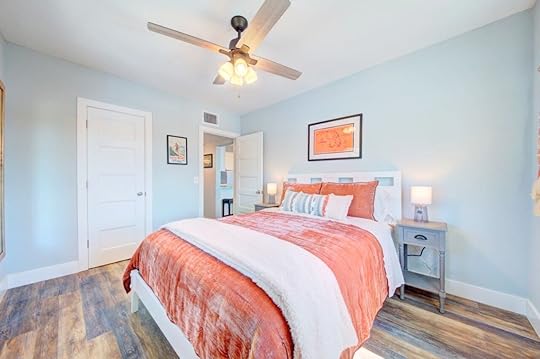 Photo: Airbnb
Photo: Airbnb Photo: Airbnb
Photo: Airbnb Photo: Airbnb
Photo: AirbnbSee more photos
This centrally located apartment is perfect for any guest’s beach getaway fantasies. This home is in downtown Cocoa Beach right near all the action and within walking distance of everything like restaurants, bars, shopping, and the beach. It’s also a 14-minute drive to Port Canaveral and a 33-minute drive to the Kennedy Space Center Visitor Complex.
Four guests, one bedroom
Price: $180 per night
Newly renovated beach house only two minutes to the Cape Canaveral beach
 Photo: Airbnb
Photo: Airbnb Photo: Airbnb
Photo: Airbnb Photo: Airbnb
Photo: Airbnb Photo: Airbnb
Photo: AirbnbSee more photos
This luxury newly renovated home is just a two-minute walk to the beach. The finishings include a new kitchen, bathroom, appliances, and flooring. All bedrooms and the sleeper sofa are equipped with queen beds. There is a spacious private backyard with seating and a gas grill, and there is also beach equipment in the home if guests need extra beach gear.
Eight guests, two bedrooms
Price: $250 per night
 Photo: Airbnb
Photo: Airbnb Photo: Airbnb
Photo: Airbnb Photo: Airbnb
Photo: Airbnb Photo: Airbnb
Photo: AirbnbSee more photosThis Florida Airbnb has all the trappings for a family vacation on the Gulf Coast of the Sunshine State. Besides the sizable living quarters and bedrooms, the house has a screened-in pool and backyard with a fishing dock. The host provides kayaks and there is a slip to bring your own boat. It’s great for kids and dogs are welcome too.
Eleven guests, three bedrooms
Price: $195 per night
 Photo: Airbnb
Photo: Airbnb Photo: Airbnb
Photo: Airbnb Photo: Airbnb
Photo: Airbnb Photo: Airbnb
Photo: AirbnbSee more photosWhisk the family away to Casey Key, a barrier island popular with bikers and bestselling authors – Stephen King will be your temporary neighbor. This luxury Florida Airbnb comes with kayaks, paddle boards, and bikes plus a landscaped pool with waterfalls. The host can share boat rental contacts and dolphins make frequent appearances in the surf.
Five guests, two bedrooms
Price: $529 per night
Florida Airbnbs for a getaway to the beachCharming beachfront condo on east side of Sanibel Island
 Photo: Airbnb
Photo: Airbnb Photo: Airbnb
Photo: Airbnb Photo: Airbnb
Photo: Airbnb Photo: Airbnb
Photo: Airbnb Photo: Airbnb
Photo: AirbnbSee more photos
This exquisite beachfront condo is perfect for any guest’s beach getaway fantasies. The condo has newly renovated granite countertops and bathrooms. The main bedroom has a small patio with stunning beach views, and the second bedroom has two twin beds perfect for guests with children. The home is on the east side of Sanibel Island, just a few feet away from Sanibel`s famous Lighthouse beach.
Four guests, two bedrooms
Price: $409 per night
 Photo: Airbnb
Photo: Airbnb Photo: Airbnb
Photo: Airbnb Photo: Airbnb
Photo: Airbnb Photo: Airbnb
Photo: AirbnbSee more photosThis treehouse-inspired cabin sits on the shore of Crescent Beach in the historic Florida town of St. Augustine. You’ll rent the entire top floor which delivers the best ocean views from inside and the wraparound verandah. The penthouse has one ultra-comfy bed, a modern kitchen, and ample seating space. Larger groups can enquire about booking the entire shack or hosting a wedding.
Four guests, one bedroom
Price: $292 per night
 Photo: Airbnb
Photo: Airbnb Photo: Airbnb
Photo: Airbnb Photo: Airbnb
Photo: Airbnb Photo: AirbnbSee more photosThis pet-friendly Airbnb on Florida’s Space Coast is primed for day trips to amusement parks, state reserves, and golf courses. Kennedy Space Center is just up the road although you might be lucky to catch a launch from the sun deck. The decor reflects the aquatic surroundings and local wildlife; in fact, book a stay in spring or summer and you’ll spy nesting sea turtles.
Photo: AirbnbSee more photosThis pet-friendly Airbnb on Florida’s Space Coast is primed for day trips to amusement parks, state reserves, and golf courses. Kennedy Space Center is just up the road although you might be lucky to catch a launch from the sun deck. The decor reflects the aquatic surroundings and local wildlife; in fact, book a stay in spring or summer and you’ll spy nesting sea turtles.
Five guests, two bedrooms
Price: $451 per night
 Photo: Airbnb
Photo: Airbnb Photo: Airbnb
Photo: Airbnb Photo: Airbnb
Photo: Airbnb Photo: Airbnb
Photo: AirbnbSee more photosThis brand-new vacation rental near Destin is well-placed for exploring Florida’s Gulf of Mexico beaches and diving the Shipwreck Trail. Floor space is generous across the open-plan lounge and the bedrooms which have ocean views and balconies. The home has direct access to the beach, a private pool, and a garage stocked with leisure gear. There’s even an elevator which lightens the load for heavy packers.
Fourteen guests, four bedrooms
Price: $499 per night
 Photo: Airbnb
Photo: Airbnb Photo: Airbnb
Photo: Airbnb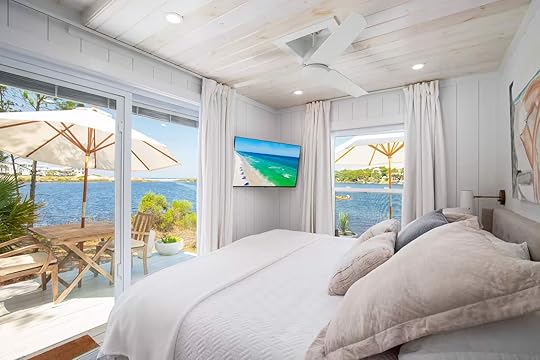 Photo: Airbnb
Photo: Airbnb Photo: AirbnbSee more photosThirty minutes from downtown Destin, this waterfront Airbnb for couples looks over the Gulf of Mexico channel and grants access to one of Florida’s rare dune lakes. The yard has a private launch for making use of the provided paddle boards and canoe, and you’ll experience spellbinding sunsets from the water or the deck. Even the bedroom and lounge have water views, thus creating the sense of being adrift.
Photo: AirbnbSee more photosThirty minutes from downtown Destin, this waterfront Airbnb for couples looks over the Gulf of Mexico channel and grants access to one of Florida’s rare dune lakes. The yard has a private launch for making use of the provided paddle boards and canoe, and you’ll experience spellbinding sunsets from the water or the deck. Even the bedroom and lounge have water views, thus creating the sense of being adrift.
Two guests, one bedroom
Price: $239 per night
 Photo: Airbnb
Photo: Airbnb Photo: Airbnb
Photo: Airbnb Photo: Airbnb
Photo: Airbnb Photo: Airbnb
Photo: AirbnbSee more photosThis top-rated vacation villa has as much space outdoors as inside. The main lounge links the chef’s kitchen and the patio and there’s a separate den where kids can spread out with toys. The fenced backyard has a saltwater pool and hot tub as well as a putting green for golf or bowling. Dine like a true Floridian on the covered terrace or walk two minutes to Las Olas Boulevard.
Eight guests, four bedrooms
Price: $1,478 per night
Oceanfront condo with panoramic beach views
Headed to central Florida on a Disney World trip? Check out Matador’s central Florida Airbnb guides:
8 of the coolest Airbnbs near Disney World The best Airbnbs near Universal Studios Kissimmee Airbnbs for a multi-generational family vacation to Disney
 Photo: Airbnb
Photo: Airbnb Photo: Airbnb
Photo: Airbnb Photo: Airbnb
Photo: Airbnb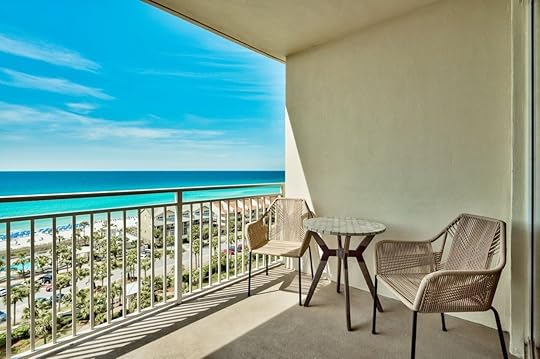 Photo: Airbnb
Photo: AirbnbSee more photos
This oceanfront condo has everything you need for your sunshine state vacation. There is a spacious living area with a patio overlooking the beautiful ocean. Other amenities included are a lagoon pool, oceanfront heated pool, gas grills, work-out room, tiki bar. The condo is also within walking distance of popular restaurants, shops, and entertainment, along with top amenities.
Six guests, two bedrooms
Price: $249 per night
The Lucky Dune Bird condo
 Photo: Airbnb
Photo: Airbnb Photo: Airbnb
Photo: Airbnb Photo: Airbnb
Photo: Airbnb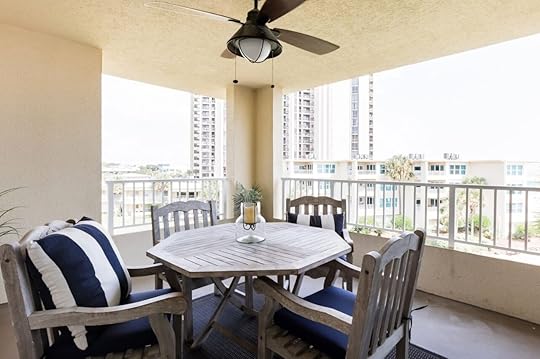 Photo: Airbnb
Photo: AirbnbSee more photos
Another stunning oceanfront Destin condo is ready for you to relax and soak up the sun in. This Florida Airbnb condo has a fully equipped kitchen and living room that leads right out to the patio with an ocean view and the calming sound of waves crashing along the shore. The apartment is centrally located to grocery stores and other Destin entertainments like an amusement and water park.
Eight guests, two bedrooms
Price: $450 per night
Beachfront unit on private beach
 Photo: Airbnb
Photo: Airbnb Photo: Airbnb
Photo: Airbnb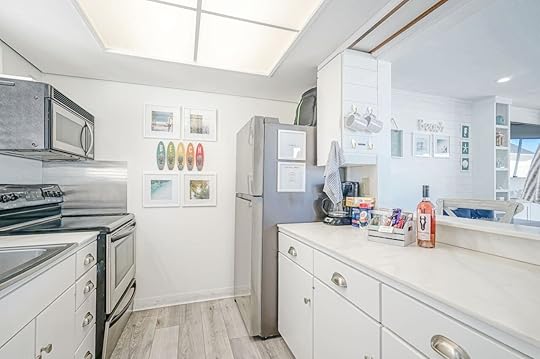 Photo: Airbnb
Photo: AirbnbSee more photos
This newly remodeled Florida property is a top-floor unit above a private beach. This condo is perfect for groups, families, or couples looking to hang out in the quiet and secluded beach area. The home can sleep up to six guests as it has a king-sized bed in the main bedroom, a sleeper sofa, and two bunked beds.
Six guests, one bedroom
Price: $329 per night
 Photo: Airbnb
Photo: Airbnb Photo: Airbnb
Photo: Airbnb Photo: Airbnb
Photo: Airbnb Photo: Airbnb
Photo: AirbnbSee more photos
This bright and spacious apartment is located right in the heart of Victoria Park. The apartment features a spacious living room with floor-to-ceiling windows and natural lighting. There is also a private patio with a seating area where guests can sit out and enjoy all of the Florida sunshine. The home is not too far from the Fort Lauderdale activities like Las Olas Boulevard, and it’s also a five-minute drive to the beach.
Four guests, one bedroom
Price: $180 per night
 Photo: Airbnb
Photo: Airbnb Photo: Airbnb
Photo: Airbnb Photo: Airbnb
Photo: Airbnb Photo: Airbnb
Photo: Airbnb
See more photosStay in the heart of Florida’s entertainment capital and bask under the sunshine with a private backyard complete with a pool, bar, table tennis, and hammocks. This twee cottage, or micro resort, in Lake Enola Heights is designed for a couple and has everything needed for cooking and grilling. Otherwise, there are restaurants within five minutes and the CBD is two blocks away.
Three guests, one bedroom
Price: $198 per night
 Photo: Airbnb
Photo: Airbnb Photo: Airbnb
Photo: Airbnb Photo: Airbnb
Photo: Airbnb Photo: Airbnb
Photo: AirbnbSee more photosBeach or pool? How about both? This modern Airbnb in Melbourne Beach, FL, has a heated private pool with jet stream functions and direct access to the pristine sand. This is a minimalistic home with ocean views from most rooms and an open-concept kitchen with an island. Besides the pool deck, there’s a second-floor terrace from where you might catch a rocket launch.
Eight guests, four bedrooms
Price: $550 per night
 Photo: Airbnb
Photo: Airbnb Photo: Airbnb
Photo: Airbnb Photo: Airbnb
Photo: Airbnb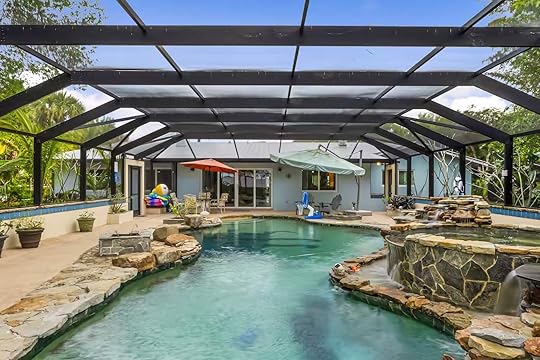 Photo: Airbnb
Photo: AirbnbSee more photosThis Guest Favorite Airbnb in Florida lets you experience everything the Sunshine State is known for. Steps from the beach, you’ll wake up to the sound of waves and have the option to dive into the surf or take a dip in the enclosed pool. The home sits in a tropical garden and has a boat slip complete with kayaks. Orlando and Miami are each a two-hour drive from the house.

Fourteen guests, five bedrooms
Price: $460 per night
Get The Most Out of Sacramento At These Guest Favorite Airbnbs

Certain destinations in the US have a particularly hot Airbnb scene. Many of these are in California. San Diego, Death Valley, Joshua Tree, and rentals near Palm Springs come to mind, but Sacramento Airbnb rentals are challenging Californian hosts with a focus on detail and offerings of amenities that will make a vacation to the state unforgettable. These properties sizzle with generous outdoor spaces with pools, beautifully furnished patios, backyard games, and interiors, which will have you planning your Pinterest board for a home renovation on your return. These are some of the best Airbnbs in Sacramento and the surrounding area that you need to bookmark now.
We hope you love the Airbnb Sacramento rentals we recommend! Just so you know, Matador may collect a small commission from the links on this page if you decide to book a stay. Listed prices are accurate as of the time of publication.
The best Airbnbs in Sacramento for solo travelers and couplesCharming duplex near Curtis Park Photo: Airbnb
Photo: Airbnb Photo: Airbnb
Photo: Airbnb Photo: Airbnb
Photo: Airbnb Photo: AirbnbSee more photos
Photo: AirbnbSee more photosThis is one of the top five percent listings in the city. With a lovely outdoor space in a quiet and welcoming community, this home is ideal for those looking for a low-key homely stay. It’s situated in the Curtis Park neighborhood in a residential area and features a spacious bedroom, a fully equipped kitchen, and a comfortable living room. You can stroll from the front door to Curtis Park — where you’ll find a basketball court, tennis court, baseball field, large yard for soccer, and a track to walk or run — and it’s minutes from superb restaurants and shops.
Four guests, one bedroom
Price: $160 per night
 Photo: Airbnb
Photo: Airbnb Photo: Airbnb
Photo: Airbnb Photo: Airbnb
Photo: Airbnb Photo: AirbnbSee more photos
Photo: AirbnbSee more photosAnother top-percent rental is this light-drenched Victorian loft in the heart of Midtown. You’ll need to climb two flights of stairs to reach the light, but the effort will be worth it. When you reach the nest, you’ll find a spacious studio apartment, which has been lovingly renovated. It has a dedicated office space, so it’s ideal if you visit on a workcation. And Midtown puts you smack in the middle of the action. It’s a super fun neighborhood where the trendy will fit in perfectly. You’ll have walkable access to concert venues, art galleries, and excellent coffee shops, so you’ll feel like a local in no time.
Four guests, one bedroom
Price: $129 per night
 Photo: Airbnb
Photo: Airbnb Photo: Airbnb
Photo: Airbnb Photo: Airbnb
Photo: Airbnb Photo: AirbnbSee more photos
Photo: AirbnbSee more photosYou’ll have to race me to book this cottage in East Sacramento. It’s ticking all the boxes — especially for the discerning traveler. The location is unbeatable. This central home base offers easy access to many Northern California attractions. Within a few miles, you’ll find Golden One Arena, the tranquility of Sacramento and American Rivers, or the outdoor recreation of Discovery Park. For water activities, Lake Natoma and Folsom Lake are within a short drive. And it’s easy to see why many choose Sacramento as a base for exploring California. Venture a bit further (one to three hours) to explore the Sierra Foothills, historic Gold Rush Country, the Amador Wine Region, Calaveras Giant Sequoias, Truckee and Donner Lake, Lake Tahoe, Napa Valley, Sonoma Wine Region, and Yosemite. The cottage includes off-street parking, and the host goes the extra mile to ensure every detail is covered so you have a perfect stay.
Two guests, one bedroom
Price: $199 per night
 Photo: AirbnbSee more photos
Photo: AirbnbSee more photosMidtown can be expensive, especially if you’re a solo traveler looking for a hotel room. This Airbnb, priced at just over $100 per night, is a steal. Tucked away in the Midtown district of Sacramento, this thoughtfully renovated one-bedroom apartment offers a stylish and comfortable retreat. With its prime location, just steps from the city’s renowned farm-to-fork restaurants and nightlife, this Airbnb is one of the best in the area. The apartment has a kitchen, with sleek appliances and ample counter space, and a spacious bedroom featuring a queen-sized bed and a walk-in closet. While there’s no on-site outdoor space, the apartment’s central location allows easy access to the city’s many outdoor amenities.
Two guests, one bedroom
Price: $108 per night
 Photo: Airbnb
Photo: Airbnb Photo: Airbnb
Photo: Airbnb Photo: Airbnb
Photo: Airbnb Photo: AirbnbSee more photos
Photo: AirbnbSee more photosIn the heart of Sacramento’s historic East Sacramento district, this charming two-bedroom, one-bath home offers a delightful retreat for couples looking for a chic but convenient stay. The home caters to the needs of families with young children, so if you’re traveling with a baby, they’ve got you covered. Changing tables, high chairs, and kid-friendly tableware make mealtimes and diaper changes a breeze. The spacious living room with a comfortable seating area and a TV is ideal for movie nights and quality time together. For those needing to stay connected during their travels, a dedicated workspace with fast and reliable internet access is available. And the outdoor patio is a wonderful space to enjoy your morning coffee al fresco or dine under the California sun.
Six guests, two bedrooms
Price: $178 per night
 Photo: Airbnb
Photo: Airbnb Photo: Airbnb
Photo: Airbnb Photo: Airbnb
Photo: Airbnb Photo: AirbnbSee more photos
Photo: AirbnbSee more photosNow for a little more space. And with space comes more amenities. This guest favorite stylish residence sleeps six. As you step through the front door, you’re greeted by an interior bathed in natural light, courtesy of the large windows that frame the space. The freshly remodeled kitchen, with its sleek quartz waterfall island, is a culinary enthusiast’s dream. As the day draws to a close, you can open the floor-to-ceiling sliding glass doors and let the outdoors in. The backyard has a pool, shaded gazebo, and lush garden. As the sun dips below the horizon, the backyard transforms into a mini retreat, ideal for stargazing or simply enjoying the quietude.
Six guests, three bedrooms
Price: $593 per night
 Photo: Airbnb
Photo: Airbnb Photo: Airbnb
Photo: Airbnb Photo: Airbnb
Photo: Airbnb Photo: AirbnbSee more photos
Photo: AirbnbSee more photosThis spacious three-bedroom home is another top-percent listing in a family-friendly neighborhood, just a stone’s throw from the riverfront and Sutter Health Park. The open-concept living area is bathed in natural light, and the bedrooms are equally inviting. The fully fenced backyard is perfect for outdoor dining, fireside chats, or a friendly game of cornhole. When/if you’re ready to leave the Airbnb and explore the city, you’ll find many attractions within easy reach. You can stroll along the Sacramento Riverfront, visit the historic Old Sacramento Waterfront, or catch a game at Sutter Health Park.
Eight guests, three bedrooms
Price: $434 per night
 Photo: Airbnb
Photo: Airbnb Photo: Airbnb
Photo: Airbnb Photo: Airbnb
Photo: Airbnb Photo: AirbnbSee more photos
Photo: AirbnbSee more photosThis Airbnb in the heart of Land Park is ideal for a group of adults. Again, the star of the show is the outdoor space. Although there’s no pool, the patio is stunning and is accessible from French doors in one of the bedrooms and the dining room. The interior is modern, with splashes of colorful art and furnishings. It’s worth noting that outdoor cats might be milling around, so if you have allergies, this is not a rental for you. If that’s not an issue, you’ll benefit from a Peloton bike, organic mattresses, and a reverse osmosis water system — if that interests you.
Six guests, four bedrooms
Price: $605 per night
 Photo: Airbnb
Photo: Airbnb Photo: Airbnb
Photo: Airbnb Photo: Airbnb
Photo: Airbnb Photo: AirbnbSee more photos
Photo: AirbnbSee more photosNow, let’s move on to a couple of outstanding rentals that are outside the city boundaries. This stellar home is in Fair Oak (20 or so minutes from Sacramento). Sleeping 13, this Airbnb is wild. The Jananses-Scandinavian-inspired home looks more like a spa than a vacation rental. There’s an indoor pool, soaking tub, sauna, rain showers, two fireplaces, and spacious hotel-quality bedrooms. The backyard has a BBQ area and a porch with covered outdoor seating.
13 guests, four bedrooms
Price: $797 per night
 Photo: Airbnb
Photo: Airbnb Photo: Airbnb
Photo: Airbnb Photo: Airbnb
Photo: Airbnb Photo: AirbnbSee more photos
Photo: AirbnbSee more photosIf you need more space, you’ll want to check out this luxury castle retreat in Davis. It’s a baller option if you’re looking for a place for a reunion or have a blended family and can put funds together to spread the cost. There are three accommodations — a grand castle, a charming fairytale retreat, and a cozy cottage. You’ll find elegant living spaces in the main castle, a state-of-the-art home theater, a well-stocked wine cellar, a game room, and a private turret, which offers breathtaking panoramic views of the surrounding countryside. Beyond the stunning accommodations, the five-acre estate offers outdoor activities for all. You can take a dip in the infinity pool, paddle on the private lake, challenge your friends to a game of basketball, or stroll the manicured gardens and walking trails. 
16+ guests, seven bedrooms
Price: $3,309 per night
December 17, 2024
Shaun White Discusses WHITESPACE and Why the World Needed Another Snowboard Brand

Iconic snowboarder Shaun White retired from professional competition following the 2022 Beijing Olympics, with 3 Olympic Gold medals, 15 X Games Gold medals in snowboarding along with another five medals in skateboarding, and a slew of other accomplishments. White is without a doubt the most decorated athlete in the sport’s history. Although he’s done competing, White is far from removing himself from the snowboard world altogether. Quite the opposite, in fact – he recently launched WHITESPACE, a fashion-forward, high-end snowboard brand crafting boards, gear, and streetclothes for snowboarders across age groups.
We hope you love WHITESPACE! Just so you know, Matador may collect a small commission from the links on this page if you decide to make a purchase.
WHITESPACE snowboards and gear are designed by Shaun White himself, so expect them to pop off booters and carve tight lines in the manner that White pioneered throughout his career. Matador spoke with White about why he launched WHITESPACE, where the snowboard industry is headed, and what still stokes him out about riding after all these years.
Shaun White speaks to the ethos and design of WHITESPACE
Photo courtesy WHITESPACE
Matador: What is WHITESPACE doing that other boutique snowboard brands aren’t? What’s fresh, in your opinion?White: When I started WHITESPACE, I wanted to make sure I was involved in every single detail when it came to the brand: design, creative, marketing, production of the goods and so much more. Taking so many years of riding, and my personal expertise and vision, offers a level of authenticity and performance for not only professional riders, but also beginners and intermediate levels.
I also made sure to blend high-performance snowboarding gear with fashion-forward designs, creating products that are both functional on the slopes, while stylish off them. As someone who travels a lot of the year with my snowboard bag, versatility is important to me. I want a product you can wear on the mountain, but also around the streets of NYC or LA.
Snowboarding has given me so much and broadened my horizon, and I think Whitepace offers the high-performance functionality that enables riders to progress on the snow and a fashion-informed style that can take them anywhere. That versatility is super important to me. I started riding when I was really young and it was important to me that we have snowboards for the next generation to progress on, and for riders at every level.
Matador: What lessons or skillsets have you brought from your competing days into starting a brand like this?White: As a rider, striving for the perfect trick or grab and pushing the limits of what’s possible has always been second nature to me. That means making sure that every product or decision we make for WHITESPACE meets the highest standards of quality and performance, with even the smallest details considered.
When I was competing, I always had to adjust to unexpected conditions— whether that was the weather, competition formats changing, or the physical and mental pressures of expectations. I think I’ve taken all those skills and now have put them into the business: the ability to pivot when needed, looking at the evolving demands of product creation, and figuring out any logistical or creative challenges. After a lifetime on my snowboard I have spent an enormous amount of time thinking about the little details, like how to make sure that your car keys stay in your cargo pockets when you’re upside down or how to get just the right amount of pop from a board’s camber to sail over a jump into the sweet spot of the landing, or what kind of sidecut makes for the most fun tree runs, and my brother and I have collaborated to make sure that the products perform to the highest standards.
I am very fortunate to have a team around me who share that same vision. My brother, Jesse, and I have worked together on brands for years. We work well together, and know each other’s strengths and weaknesses. He is one of the main brains behind WHITESPACE, and if there is something that I think may work that he may not always agree with, I trust that he has a different set of skills and expertise than me, and knows what will work best for the company.
Matador: What excites you about snowboarding and the industry around it right now?White: It’s an interesting time in snowboarding. Since the pandemic, more people have tried snowboarding, and discovered how amazing it is, no matter your skill level. It’s exciting environment. It’s exciting to see more diverse community activation going on, more representation on the slopes and the welcoming vibe that all snowboarders deserve. The more people who get to experience that feeling of sliding on snow, and the ways that it can expand your horizon, the better.
We’ve also seen incredible progression at the top level of the sport, and the boundaries that we used to think existed, no longer exist. They’re building a next level airbag training set up at WyEast Academy in Oregon that will allow riders at the forefront of snowboarding to continue to progress in a safer environment, and the kids who go to High Cascade and Windell’s in the summer will get to experience it ahead of the next winter Olympics. And of course I’m super pumped on the debut of the Snow League this year. Snowboarding has needed an event series like this for a long time, and I can’t wait to see it come into existence.
Matador: Retail store growth forthcoming or is the focus on online sales?White: We currently have retail partners and direct sales on our website and we plan to expand in both areas.

Photo courtesy WHITESPACE
Check out the coolest products from WHITESPACEFreestyle Shaun White Pro snowboard
Photo courtesy WHITESPACE
The WHITESPACE Freestyle Shaun White Pro snowboard, designed and tested by Shaun White himself, is iconic of what White wants to do with this brand. It’s built to his specs for pipe, park, and freeriding, and comes in two color combinations and a variety of sizes based on rider weight, ranging from 132 cm to 165 cm. The board boasts carbon construction, a responsive camber profile, and a high-performance sintered base – so you know it’ll fly in the park. It utilizes a directional twin shape, a poplar and paulownia core, triaxial ultra dense weave fiberglass, C4X carbon fiberglass, a reduced sidecut radius, plant-based bio-resin, thermoplastic ABS sidewalls, and water-based inks.
Price: $649
Women’s AMF Twin snowboard
Photo courtesy WHITESPACE
This snowboard, available in two color combinations and a variety of sizes, is designed for women who spend as much time in the park as they do in the trees. It features ultralight carbon-infused fiberglass, a premium sintered base, and a playful camber profile designed to pop off kickers and side hits. Like the Freestyle Shaun White Pro, it utilizes a directional twin shape, a poplar and paulownia core, triaxial ultra dense weave fiberglass, C4X carbon fiberglass, a reduced sidecut radius, plant-based bio-resin, thermoplastic ABS sidewalls, and water-based inks.
Price: $619
Magnetic MD Icon goggles
Photo courtesy WHITESPACE
The Magnetic MD Icon goggles from WHITESPACE, available in four colors, feature an innovative beveled-edge lens with a magnetic changing system for easy lens swapping. The goggles come equipped with a premium injection-molded cylindrical lens for superior strength and clarity, as well as high contrast technology to enhance depth perception. Notable features include OTG compatibility, armored venting, and a silicone-backed strap. White’s focus in creating a pair of goggles was on precision vision, effortless versatility, and comfort in any winter setting – from pow days to flat light.
Price: $299.95
3L Performance 3-in-1 Jacket
Photo courtesy WHITESPACE
This jacket comes in four colors and a variety of sizes, ranging from XXS to XXL. The jacket features a 3-layer waterproof shell integrated with a removable 3L softshell liner. Its components include Bemis® 3L seam tape and YKK VISLON® AquaGuard® Zippers, and it is made with PFC-free Durable Water Repellent. Some additional notable features include Passive Airflow (PAS) venting, a sleeve pass pocket, and articulated patterning. White rides his gear hard, so expect the 3L jacket to last for many years of heavy use — from the park to the backcountry.
Price: $549
Unconventional Athletics hoodie
Photo courtesy WHITESPACE
The Unconventional Athletics hoodie – designed for women, but certainly wearable by all – comes in two colors and all sizes. It’s made with a mid-weight 80% cotton and 20% recycled polyester fleece blend, meaning its free of new plastics. The hoodie features chest and sleeve embroidery, a relaxed fit, a pullover hood, drop shoulders, a kangaroo pocket, a lined hood, no drawcord, and sleeve cuff ribbing. WHITESPACE positions the hoodie as more than just a piece of clothing, but a representation of a mindset that celebrates individuality and nonconformity – as “to the core” of snowboarding as it gets. 
Price: $99
More like thisSki and SnowHere's All the Gear and Resources You Need to Plan a Splitboarding TripLooking for a Luxurious Last-Minute Holiday Getaway? It’s Hard to Beat a Private Vineyard Stay in California Wine Country

Where to stay to celebrate the holiday season is the first question anyone traveling at the end of December and into the new year needs to consider. There are trips to see grandparents, relaxing staycations, renting a massive Airbnb to house even the far reaches of your extended family. Or, for something truly unforgettable, you can stay with your family and friends in California’s Sonoma wine country and have an entire vineyard to yourselves.
Bricoleur Vineyards started a new holiday experience this year that it’s calling a “Festive Fête Stay.” Luxury is baked into the three-night stay in the four-bedroom Vineyard Residence. Holiday decorations abound around the 2,750-square-foot home, from the open kitchen to the indoor and outdoor living spaces, the media room, the game room, and the expansive deck. Views from the property include the estate vineyards, Mount St. Helena, and the Mayacamas Ridge.
The location and home is a draw on its own. The experiences that come along with the stay take it another step further. A basket of fresh goods and produce starts things right — think the estate’s extra virgin olive oil, custom Bricoleur x Tsar Nicoulai Cavair sets, and a risotto with dried mushrooms kit. Recipe cards from Bricoleur’s executive chef Todd Knoll and senior sous chef Rebeca Robinson make the farm-fresh holiday meal planing easy. As an added bonus, a framed sketch on how to plate the feast from Knoll is useful in the moment and a great keepsake when you return home.
This being a vineyard, wine is of course part of the experience. Winemaker Tom Pierson hand-selected a set of Bricoleur Vineyards bottles — bubbly, chardonnay, and pinot noir — that pair with the food. Also included is access to a concierge and a complimentary tasting experience for up to eight guests complete with a six-course wine and food pairing.
View this post on InstagramA post shared by Bricoleur Vineyards (@bricoleurvineyards)
Bricoleur Vineyards (the name comes from a French term meaning someone who builds with no clear plan and cobbles together a whole by the seat of their pants) opened in Windsor, Sonoma County, in 2020. It isn’t exactly an entirely new kid on the block, however. Founder Sarah Hanson Citron is the great-great-granddaughter of Pietro Carlo Rossi, one of the pioneers of early California winemaking in the 19th century. The sustainable, small-production winemaking at Bricoleur continues that legacy.
Is this your typical last-minute holiday planning destination? Definitely not. But is one that will set a high standard for every holiday to come. For pricing and more details, reach out to Bricoleur Vineyards on the Festive Fête Stay page. 
Traveling With Presents? Follow This Tip and Don’t Let the TSA Be the Grinch This Year

There’s nothing quite like traveling home for Christmas. Well, once you’ve got the journey part out the way, of course. Because I lived overseas for most of my adult life, I made this pilgrimage most years with a suitcase full of gifts for my family from overseas.
This weekend, a university friend Candice Wood flew back from California to her birth country, Scotland, with just that: luggage full of perfectly wrapped Christmas presents. Candles for mom, a comical T-shirt for dad, chocolates, a photo album, and even a yoga mat for her sister, all tied up with a bow. When she arrived at her hotel in Glasgow, she noticed a baggage inspection card had been placed in her duffle and her expertly wrapped goodies had been opened.
“TSA not only opened all my gifts,” Wood says on arrival at my home on Sunday, “but they did a Grinch job of trying to re-wrap them.”
She needed a few new rolls of paper and sticky tape. Luckily, I had a holiday box at the ready that she could raid.
This has never happened to me before. I’ve never had my luggage expected, but that said, I’ve never flown with wrapped gifts. The TSA clearly states they do not recommend packing sealed presents in either carry-on or checked baggage.
While it may seem like a good idea to wrap ahead of time to save the hassle on arrival, doing so could lead to unnecessary delays and stress.
The TSA is clear: wrapped gifts are a no-no. If your present triggers an alarm during the screening process, agents will need to unwrap it to ensure it’s safe. This means your carefully curated wrapping job could be undone, potentially damaging the gift. Instead, they recommend waiting until you reach your destination, mailing your gifts, or using gift bags, which are easier to inspect.
Need some travel inspiration for 2025? Check out Matador’s Awards for 2024: Matador Network Awards 2024: Wellness DestinationMatador Network Awards 2024: Sustainable Destination
Matador Network Awards 2024: Adventure Destination
Matador Network Awards 2024: Next Big Destination
Matador Network Awards 2024: Best Airline
It’s also worth reminding yourself what you can bring through security if you pack presents in your carry-on. Just because it’s the holidays, don’t think items like snow globes will get a pass (unless they are under 3.4 ounces and fit in a quart-sized bag.) Some unexpected items are not allowed, so brush up on what you can take to stay on the Nice List. TSA has a neat tool enabling you to search for specific objects. Interestingly, you can take a chocolate advent calendar through security without TSA needing to open all the doors.
If you’re anything like me, you might want to bring wine home to your family this Christmas. You can pack it in your checked luggage. When I lived in Chile, I’d make the long journey with at least a couple of bottles of red. While I was nervous about the wine exploding all over my holiday sweaters, careful packing with bubble wrap or wrapping in soft clothing meant I never had an issue.
TSA has further information regarding food items in carry-ons. Solid foods like cookies, cakes, and pretzels are generally a go. However, liquids, gels, and aerosols, including jams, jellies, and soft cheeses, must be 3.4 ounces or smaller and fit in a quart-sized bag. Larger containers should be checked. I was recently stopped at security for trying to carry butter back from Norway. It was over the liquid limit, but I never considered it an issue. As that regional butter is particularly special, the agent did apologize and genuinely seemed sorry for my loss.
So, if you’re flying this holiday season, pack carefully and considering wrapping on arrival to avoid the TSA Grinch. 
December 16, 2024
How to See All of Valletta’s Highlights on a One-Day Walking Tour

Valletta, the capital city of the archipelago of Malta, the southernmost capital city in Europe, and a UNESCO World Heritage site, is tiny. At just 0.24 square miles, you can see all its highlights in a matter of a couple of hours, which is good news for the cruisers who tend to have one day, or less, on site.
Upon getting off their ship at the cruise port in Valletta, travelers will be overwhelmed with offers for electric car rentals, sightseeing bus tours, private taxi tours, and even horse-and-buggy rides. If you’re able-bodied and don’t mind putting in a few thousand steps on your Fitness app, say no to all of them. You won’t find it difficult to see the best of the city on foot. In fact, you’ll probably like it better than on board any sorts of vehicles — you really don’t want to pass on the beautiful architecture, including the traditional enclosed balconies of the residential buildings, that you’ll see by strolling the narrow pedestrian streets.
With a comfortable pair of shoes, a hat to protect yourself from Malta’s ever-present heat and sunshine, and a bathing suit in your pack, you can set off from the cruise port and quickly take in Valletta’s top spots, with enough time for a traditional drink and snack, and without having to rush to make the ship’s all-aboard time.
A free walking tour of Valletta to see all the highlightsWhile the starting and ending point of this walking tour is the cruise port, which is very close to the city center, if you’re not traveling by cruise ship, you can pick up the tour from anywhere on the map and follow the circuit.
The map and walking tour below only offer suggestions from my first-hand experience in the city. You can adjust it to your preferences, budget, and walking abilities.
Starting your walking tour of Valletta early allows for more reasonable temperatures than if you set off later in the day. It gets hot in Malta, even in November.
Upper Barrakka Gardens and Saluting Battery
Photo: kerenby/Shutterstock
From the cruise port to the peaceful Upper Barrakka Gardens is an easy but ascending 20-minute walk. The public garden built on top of the SS Peter and Paul Bastion has benches where to rest, a lovely fountain, a small café, and a row of arches that lead to a large balcony. The balcony provides great views of the Grand Harbour and The Three Cities (Vittoriosa, Senglea, and Cospicua) across the water. The Upper Barrakka Gardens get very busy, especially around 12 noon, when the canons located at the Saluting Battery, just one level below the balcony, are fired.

Photo: kavalenkava/Shutterstock
If you want to see the time-gun, as it is known, you have two options. Get to Upper Barrakka Gardens early, find a spot on the balcony by 11:30 AM, and stay there until the canons are fired. Or pay the entrance fee of $3.15 (€3) to go down to the level of the Saluting Battery itself to see the spectacle up close. If you choose the second option, you’ll also get a short lecture by the members of the Malta Heritage Trust who run the daily event.
The Upper Barrakka Gardens is home an impressive historic outdoor steel elevator that allows you to get from the gardens to the water taxi station, and vice versa, very quickly and without putting in much effort. The ride is cheap at $1.05 (€1) and includes a return trip. From the water taxi station, you can take a small boat to The Three Cities for a very modest sum. Note that the water taxi station is at the same elevation as the cruise port, but remains about six minutes away from it on foot.
St. John’s Co-Cathedral and Caffe Cordina
Photo: Anton Zelenov/Shutterstock
After having experienced the deafening sound of the time-gun at the Upper Barrakka Gardens, make your way to the biggest attraction in the city: St. John’s Co-Cathedral.
It costs $15.77 (€15) to enter St. John’s Co-Cathedral, but it’s worth every penny. Inside the 16th-century edifice is an extraordinary display of baroque art and architecture, including intricate frescoes on barrel-vaulted ceilings, gilded arches, ornate marble floors, and much more that will leave you slack-jawed. The icing on the cake is the two Caravaggio paintings the cathedral houses: The Beheading of Saint John the Baptist and Saint Jerome Writing.
Note that the cathedral opens at 9 AM and that getting there as early as possible will allow you to avoid the long lines and the crowds. Plan to spend 30 to 45 minutes inside.
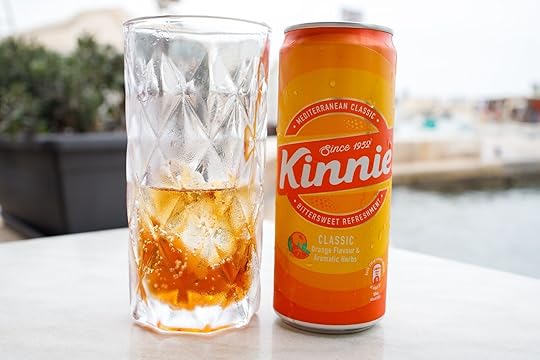
Photo: elifilm /Shutterstock
A couple of minutes’ walk from the cathedral is the early-19th-century Caffe Cordina whose patio takes up much of Republic Square. I recommend taking a seat inside, however, to see the elegant decor, including the vaulted ceilings, the chandelier, and the grand staircase. The place is busy, but the staff, in white shirt, tie, and waistcoat, won’t make you wait a minute more than necessary. To keep you going on your tour of the city, order a Kwareżimal, a traditional cross-shaped Maltese biscuit made of ground almonds and usually eaten during lent. A glass of Kinnie, a Maltese pop that combines orange and herbs, will give you the boost you need for the walk ahead.
Grand Master Palace and Basilica of Our Lady of Mount CarmelAcross the street from Caffe Cordina is the immense St. George Square where the newly restored Grand Master Palace, one the many palaces in Valletta, is located. While it is the seat of the Office of the President of Malta, visitors can explore 85 percent of the stunning 16th-century edifice during their visit. It costs (€12) to access the Grand Master Palace.

Photo: andreyandreevphotography /Shutterstock
Just three minutes away from the Grand Master Palace is the Basilica of Our Lady of Mount Carmel, which dominates the cityscape with its dome. While the basilica that was constructed on the site in the 16th century was destroyed during the Second World War, it was rebuilt into what you can see today between 1958 and 1981. The interior is grand and ornate, with tall pink columns surrounding the space, and an immense, light-filled dome above. It is free to enter.
Natural Pool in St. Elmo Bay, Fort St Elmo, and Lower Barrakka GardensFrom the Church of Our Lady of Mount Carmel to the natural pool in St. Elmo Bay is less than 20 minutes on foot. While the natural pool consists only of a six-foot-deep stone area that fills with sea water, it’s fun to go for a dip, especially when it’s sweltering in the city. If the sea is choppy, be mindful of the waves. There’s a set of stairs to get in and out of the pool.

Photo: Nicholas Courtney /Shutterstock
From the natural pool, take a 15-minute walk all around the 16th-century Fort St Elmo located on the edge of the peninsula. The path isn’t well maintained so be mindful of where you step. Fort St Elmo and the National War Museum can be visited for $10.50 (€10) and guided visits can be booked in advance.

Photo: Jean-Marc Pierard/Shutterstock
The Lower Barrakka Gardens are located 10 minutes on foot from Fort St Elmo and the National War Museum. The gardens are a great place to take a rest and check out the sea view on a bench under the shade of the palm trees. Walk around and look at the various commemorative plates, statues, and monuments, including the replica of a Roman temple, in the gardens before being back on our way to the cruise port. It’s a 20 minute walk to get there. 
Mountain Roads and Motorcycles: A Thrilling Ride Across Korea’s Scenic Routes

I’d been riding my Royal Enfield Classic 350 motorcycle out in the Korean countryside for about six months, the entirety of my riding experience, when I decided it was time to go on my first long-distance motorcycle trip. My partner and I filled our bikes’ side bags with our sleeping bags and camping chairs, tied the tent and our backpacks to the passenger seats, and set off on our coast-to-coast adventure on Korea’s old town mountain roads.
Motorcycles are not allowed on expressways in Korea, so when it’s time to swap the West Coast city bustle of Seoul and Incheon for the sandy beaches and blue oceans of the East Coast (and vice versa), bikers will take one of two roads: Hangyeryeong (Route 44) or Misiryeong (Route 56). Along the way? 5,000 feet in elevation and curves through Korea’s outstanding Seoraksan National Park. The routes are also popular with drivers looking to take the scenic route to see the epic mountain views. I heard these routes were challenging — assumedly because of the increase in travel time compared to the expressways and it being “through the mountains” — but I had very little idea of how literally “through the mountains” they really are.

Photo: Minseok Kim
There’s no better feeling than getting on a motorcycle on a warm day when the sky is blue, the sun is shining, and the wind is just cool enough to feel refreshing on your skin and hair. Particularly when there’s no place you need to be and you can drive to your heart’s content. Riding feels connected to your surroundings and you notice everything: the wind, smells, sounds, the road texture, the small (and bigger) bumps, the machinery of the bike. Hearing the roar of the engine as your hands twist to accelerate is a liberating, addictive feeling.
It wasn’t long on my ride before the highway barriers and gray roads changed to tree trunks, blurred greenery, and imposing rocky mountain walls. Corners started to appear more frequently, each one tighter than the last. I tried to keep everything I’d learned about taking corners in mind: approach slowly, lean in, and slightly accelerate out — gripping the body of the bike with my thighs as if my life depended on it. At first, it was fun, almost like a video game. We were gaining elevation when what could’ve been a nightmare began: getting stuck behind a very slow car struggling with the corners and elevation. It was getting harder to juggle accelerating enough to keep the bike going upright while staying a safe distance from the car in front. Thankfully, the car let us overtake and go ahead at the next straight.

Photo: Minseok Kim
As we were getting higher up the mountain and the roads were getting steeper, the novelty started to wear off and my focus was starting to slack. Obviously, taking it easy was not an option, so I mentally slapped myself around and gathered the rest of my little remaining energy to focus on the road ahead. Suddenly, hidden around the next, steepest corner I found myself behind a slowly moving truck. The bike was already in second gear and as I slowed down once again, the engine sound wasn’t sounding right. The RPM was getting low, which means if I didn’t switch gears or speed up, the engine was about to cut off. I made the split decision not to do either. It ended up being the right decision, as laying behind the corner was a service station where we, and the truck, sped up and pulled in.
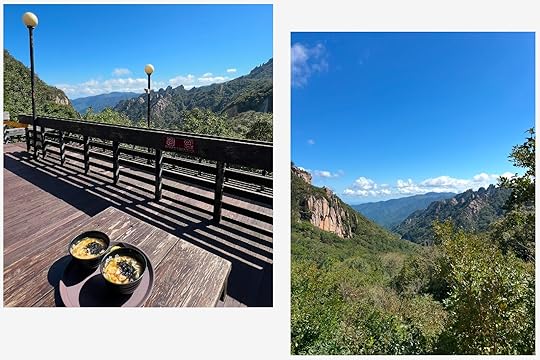
Udon with a view at the service station. Photo: Abbie Mattingly
Saved by the service station. Not the regular type. This service station sits at the highest point of the route at 5,177 feet elevation. Inside a large and old wooden cabin, the staff served traditional Korean date teas and traditional mountain foods like acorn salad, pollack soup, and savory potato pancakes. The old cabin architecture with stone-paved floors gave it a cozy feeling — perfect to sit and rest, and congratulate yourself for making it up the mountain. It felt like such a relief to arrive and I really needed that rest. Body filled with what felt like a mixture of adrenaline and cortisol, we ordered tofu skin udon soup and hot date tea, then grabbed a table outside to enjoy the mountain view we worked so hard for. It was an unrivaled view compared to anywhere else I’ve eaten at in my lifetime, and will perhaps forever remain unrivaled. For that reason, and being among the fresh mountain air and partially traumatized, the food also tasted that much more delicious.
A long way down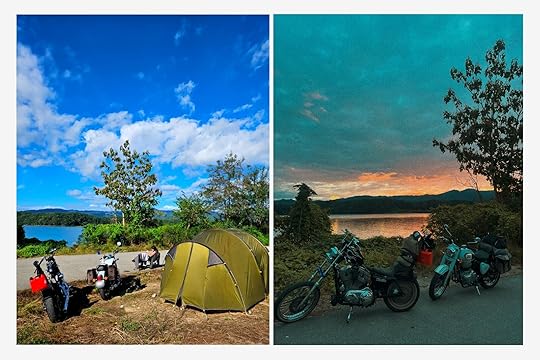
Right, camping at Chunceon; right, motorcycles at sunset. Photos: Abbie Mattingly
Why did going down suddenly seem so much more frightening? I was trying to enjoy my lunch, but it felt like I’d survived the way up by fluke and was imagining myself rolling totally aimlessly down the other side of this mountain. At least when climbing the mountain, there was relative control. Going down, however, meant a lot of braking and tight corners, which when done wrong is a recipe for a slip.
Thankfully, I didn’t face the worst case scenarios. There was a lot of grabbing the clutch to make sure the RPM didn’t fall so low that the engine would cut off. Easier than expected. And fun. It required a lot less focus than the climb, and I was able to enjoy the scenery more than on the way up.
I was grateful to see flat land as we exited the mountain roads and began onto the highways of the halfway point. We were finally free to speed on the open roads. Through this section, we passed several motorcycles coming in the opposite direction whose faces through their helmets looked just as elated as we felt, and we waved. One leader of an oncoming group of sportsbikes did a wheelie in return.
After 3 and a half hours of driving, we made it to the halfway point at Chuncheon and stopped at Sweet Potato Island (named for being in the shape of a sweet potato) to pitch up for the night. We managed to set up the tent just before dark. Resting beneath the clear skies and brightly visible stars, a canned beer and a canned highball sent us straight to sleep between the mountains, ready to continue our journey the following day.
The aftermath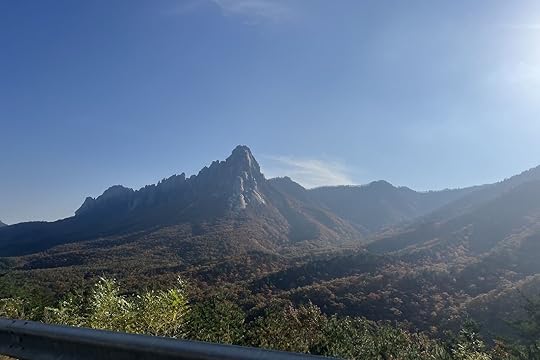
Ulsan Rock from the road. Photo: Abbie Mattingly
We headed back home via Misiryeong, the alternative but similar route. Here, the road ends on a high point with a spectacular view of Seorak Mountain’s Ulsan Rock formation, driving into a view of the gray buildings of Sokcho city and the deep blue ocean. There’s something breathtaking and sincerely relaxing about an ocean view unfolding in front of you at your destination after a long trip.
I was physically and mentally exhausted for days after our journey. Food never tasted so good. There wasn’t enough coffee in the world. Yet the voice in the back of my head kept saying, “I can’t wait to do it again next year.” I was already imagining where we could camp out.
People are impressed when they hear that my 5-foot self took these mountain routes in my first year of riding. I wasn’t planning on bragging about it, but I do now. I almost want to add it to my resume: Can ride a motorcycle on mountain roads of 5,000 feet.
How travelers can take a similar ride starting in Seoul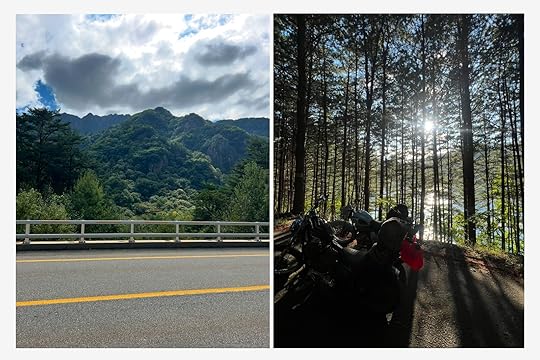
Photos: Abbie Mattingly
In Seoul, KMR (Korea Motorcycle Rental Company) comes highly recommended for sports bikes and scooters rentals. You need an International Driving Permit (IDP), accompanied by a valid driver’s license and a valid passport in the same name. Bike Club Korea has options for classic bikes, but you will need a Korean resident to sign as a guarantor.
As you might have guessed, these aren’t the routes to learn how to ride. The drives are also popular by car, many taking the route to see the spring mountain flower blooms or the fall colors, and renting a car in Korea can be a great way to explore the country with ease.
Rental companies require a minimum age (typically 21 to 25 years old), and you’ll want to book in advance during peak tourist seasons. Keep in mind that South Korean traffic can be dense and fast-paced, especially in urban areas like Seoul. Always wear proper safety gear, and familiarize yourself with local traffic laws and motorcycle-specific regulations. To make sure you can navigate without constant stops to orient yourself, learn basic Korean traffic signs and road signals, and download navigation apps with English interfaces. Google translate and other key travel apps can help immensely with both signs and speaking with locals. 
Matador Network's Blog
- Matador Network's profile
- 6 followers



